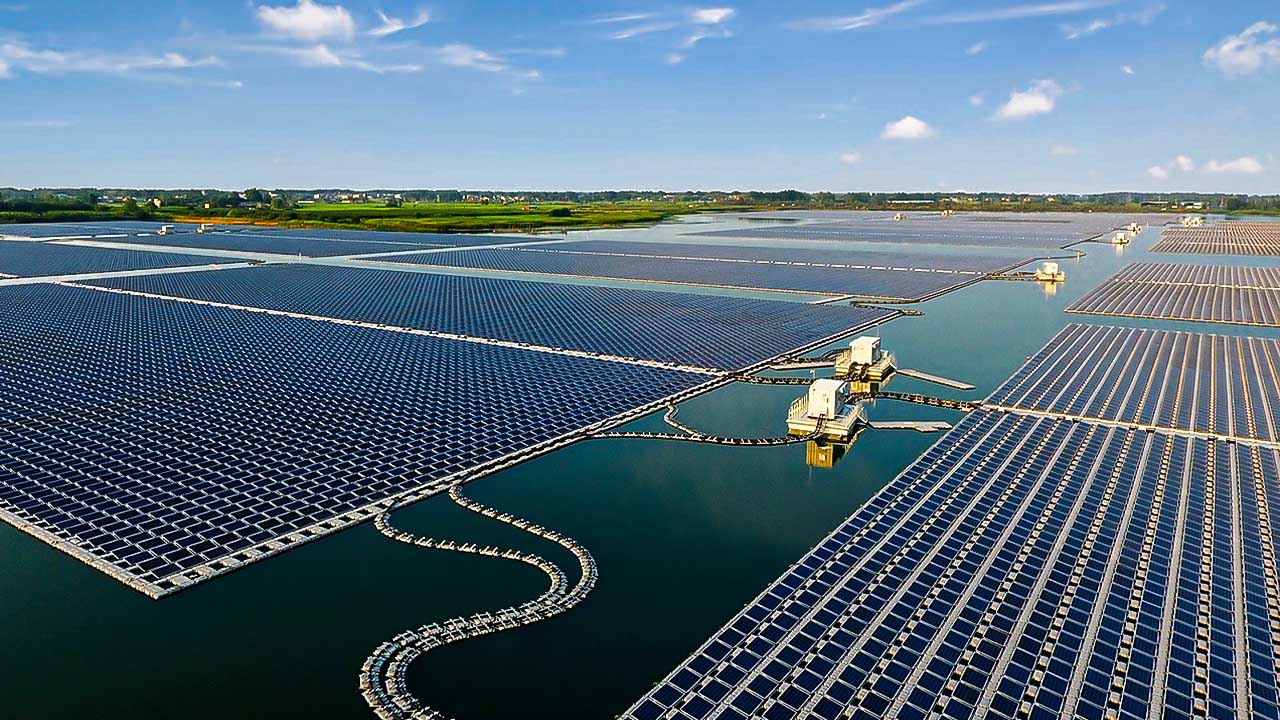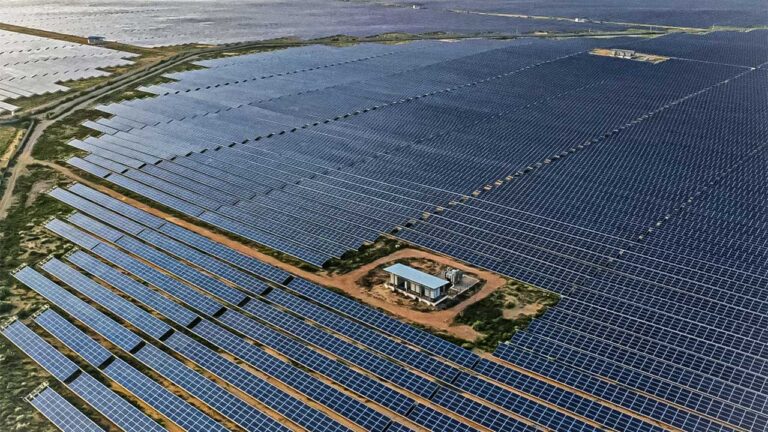Indonesia’s Cirata Floating Photovoltaic Power Plant is Largest in Southeast Asia
Indonesia, a vibrant archipelago nation in Southeast Asia, stands as a fascinating tapestry of cultures, languages, and natural beauty. Comprising over 17,000 Islands, it is the world’s largest island country, stretching along the equator between the Indian and Pacific Oceans. Indonesia has been actively working on green energy solutions, primarily due to its commitment to reduce greenhouse gas emissions and to capitalize on its vast renewable energy potential. Indonesia has plans to increase its renewable energy mix and pledged to reach net-zero emissions by 2060 or sooner. The Southeast Asian nation has committed to a 29% reduction in greenhouse gas emissions by 2030.
Indonesia recently launched the Cirata Floating Photovoltaic Power Plant on a reservoir in West Java province, boasting a capacity of 192 MWp as part of its initiative to increase renewable energy sources and reduce reliance on coal. This project is a significant achievement for Indonesia, as it now hosts the largest floating solar power plant in Southeast Asia, surpassing Singapore’s Tengeh Floating Solar Power Plant. Valued at 1.7 trillion rupiah ($108 million), the Cirata plant was developed by PLN Nusantara Power, a subsidiary of Indonesia’s state utility company Perusahaan Listrik Negara (PLN), in collaboration with Masdar, a renewable energy company from the United Arab Emirates and a unit of Mubadala Investment Company.
Today, we will explore the features of Cirata, the largest floating solar power plant in Southeast Asia. But before we start, make sure to click on the subscribe button and like this video, as it’s the best way to support our channel.
In January 2020, Masdar, a renewable energy company from Abu Dhabi, and PT PJB, an Indonesian energy company, agreed to build the 145 MW Cirata Floating Solar Power Plant. It is constructed on a 250-hectare area of the Cirata Reservoir in West Java province, Indonesia. The Cirata floating solar plant is a joint effort between Masdar and PLN. It was inaugurated by Indonesian President Joko Widodo in November 2023, marking a significant milestone for the country. The Cirata Floating Photovoltaic (PV) Power Plant is now the largest in the Southeast Asia region.
Also Read: Restoration Update of Notre Dame Cathedral
The Cirata Floating Solar Power Plant was built on the Cirata Reservoir, 108 km (67.11 miles) southeast of Jakarta, the Indonesian capital. This plant, powered by 340,000 PV Panels, covers an area equivalent to 14 Football Fields. It is expected to power 50,000 Homes and offset 214,000 Tons of carbon dioxide emissions annually. The project has created 1,400 Jobs for locals. With an expected annual production of around 300 GWh, the Cirata floating solar plant is not only Masdar’s first floating solar project but also its first venture into the Southeast Asian renewable energy market.
The Cirata Floating Solar Power in Indonesia is the most significant one built in a hydropower reservoir. It is unique due to its water depth of 100 Meters, water level fluctuation of 18 Meters, and a 50-Meter difference in water bottom elevation.
Additionally, there is a hydropower plant at the dam, which has an installed capacity of about 1,008 MW. Ranking as the third largest floating solar plant in the world, the Cirata Floating Solar Power plant has the potential to be expanded up to 1,000 MWp. To date, the 13 arrays installed occupy only 4% of the reservoir’s surface, indicating significant room for expansion.
A recent regulatory development from the Ministry of Public Works and Housing in Indonesia now allows up to 20% of water coverage for renewable energy uses which will open up the Cirata expansion to additional capacity up to 500MW as part of the Phase II of the project.
The floating solar solution for this project has been supplied by the Chinese company Sungrow FPV. It features high-load-bearing anchor blocks, which are tailored to meet the specific geological conditions of the project site. Funding for the project was secured from several international financial institutions, including Sumitomo Mitsui Banking Corporation, Société Générale, and Standard Chartered. Additionally, the project’s design underwent rigorous scrutiny by third-party audit organizations such as DNV, RINA, and INNOSEA. It also received validation from the Dam Safety Committee (DSC) of Indonesia.
Indonesia has plans to increase its renewable energy mix and has pledged to reach net-zero emissions by 2060 or sooner. The Southeast Asian nation has committed to a 29% Reduction in greenhouse gas emissions by 2030, or a 41% Reduction with international support.
The International Renewable Energy Agency (IRENA) says that if Indonesia increases its use of renewable energy, it could save up to $51.7 Billion a year. This includes benefits from reduced air pollution and climate change. Indonesia uses the most energy in the ASEAN region.
Indonesia, with more than 17,000 Islands and 100 Reservoirs – plus 521 Natural Lakes – is planning a further 60 Floating PV Installations as it chases a target of having 23% of its power generated by renewables by 2025, and 31% by 2030.
Floating Photovoltaic (FPV) Power Plants are increasingly popular due to their efficient use of space and environmental benefits. Unlike traditional solar farms, FPVs are installed on bodies of water, conserving valuable land resources. This is especially beneficial in densely populated or agricultural areas where land is at a premium.
Additionally, Floating Photovoltaic (FPV) Power Plants help in water conservation by reducing evaporation from the water bodies they cover, a significant advantage in arid regions or during droughts. The cooling effect of water enhances the efficiency of the solar panels, which tend to lose efficiency when overheated. Floating Photovoltaic (FPV) Power Plants can be seamlessly integrated with existing hydroelectric power plants, creating hybrid systems that provide more consistent energy output. This integration is a boon for energy sustainability, balancing solar power generation during the day with hydroelectric power at other times.
Also Read: China Surpasses Europe in Bridge Technology by Building the Padma Bridge
Furthermore, Floating Photovoltaic (FPV) Power Plants can reduce harmful algal blooms by limiting sunlight exposure to the water, benefiting marine ecosystems. Often, the installation costs for FPVs are lower than land-based solar systems, particularly in areas where anchoring and mooring systems are simpler. The scalability and flexibility of Floating Photovoltaic (FPV) Power Plants allow them to be tailored to the specific size and energy needs of a region. By addressing both energy generation and water management, Floating Photovoltaic (FPV) Power Plants contribute significantly to environmental sustainability. Their suitability for man-made reservoirs, such as those near hydroelectric dams or water treatment facilities, turns these areas into productive energy-generating sites.
As solar technology continues to advance and become more cost-effective, the adoption of Floating Photovoltaic (FPV) Power Plants is expected to increase, offering a promising solution to energy and land use challenges.
Floating solar plants are attractive to countries like Indonesia with expanding populations and scarce land resources. They provide higher solar panel efficiency and productivity due to the close proximity of the panels to the water surface that helps cool them. Floating panels also reduce evaporation, saving fresh water for drinking and irrigation purposes.




